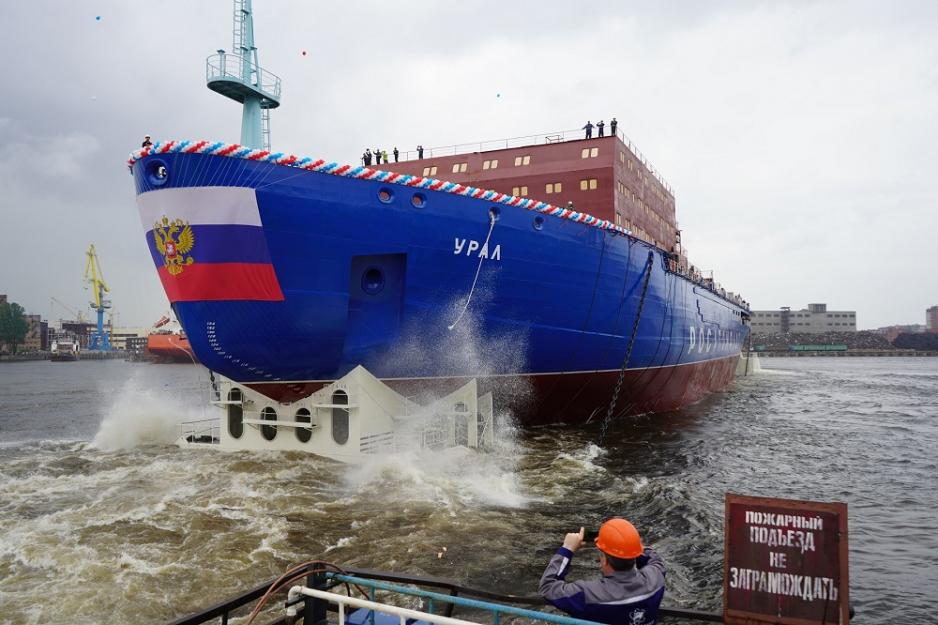Russia Plans to Commission New Arktika Icebreaker Despite Faulty Propulsion Motor

Arktika’s sister ship Ural being launched in May 2019. (Source: Courtesy of Rosatomflot)
A damaged propulsion motor will limit the power and abilities of Russia’s newest nuclear icebreaker until a permanent repair can be carried out in 2021.
Russia’s newest and most powerful nuclear icebreaker Arktika suffered from a damaged starboard propulsion motor last month placing in doubt the vessel’s scheduled commissioning date in May 2020. However, after mooring and initial sea trial Russia is now considering several options for the on-time delivery of its new flagship icebreaker. The most likely scenario appears to be the commissioning of the vessel with a reduced power output before extensive repairs in 2021, Kommersant Newspaper reports.
During sea trials last month it was revealed that the ship’s right propulsion unit, a massive motor weighing 300 tons, was faulty and would have to be replaced.
Nonetheless, the vessel continued mooring and sea trials successfully launching nuclear reactors and steam turbines. The United Shipbuilding Corporation, where the vessel was built, confirmed that the damaged propulsion unit can be operated at reduced power. As a short-term work-around the ship will likely be launched at reduced power output of 40-50MW rather than the full 60MW. The final decision to continue with more advanced sea trials and place the ship into service remains with the Russian government.
The faulty propulsion motor will then be replaced during a length stay in drydock in Kronstadt in 2021. Experts say the challenging replacement will likely take several months and may involve cutting a hole into the starboard side of the vessel through the ballast tank to gain access, remove, and replace the motor.
Not the worst-case scenario
Experts initially feared that the ship wouldn’t be able to get any power output from the damaged propulsion motor leaving the starboard propeller vulnerable to damage from ice pieces when moving through ice-covered waters. Whenever a vessel travels through ice propellers should be turning to ensure that the blades strike ice with the strong leading edge.
Even with a reduced output the vessel should still be plenty powerful for advanced sea trials and possible duty along the NSR this summer. In fact, with an output of 40-50MW, it will still rank among the most powerful icebreakers in operation.
The exact cause of the damage will only be known after disassembling the propulsion motor next year. An overvoltage when the unit was first powered on, a faulty connection, or failures during its manufacturing could all have led to the damage. Experts point out that the shipyard will want to closely evaluate the damage and take precautions to avoid similar issues in the future as four more vessels of the same type will be following by 2027.
Delivery with a three-year delay
Construction of Arktika, the lead vessel in a fleet of five planned new nuclear icebreakers, has faced ongoing delays. United Shipbuilding Corporation was awarded the construction contract in 2012 for commissioning in 2017. However technical challenges, including with the construction of a domestically-built steam turbine, resulted in a three-year delay.
With the latest setback and a stop in construction in the face of the Covid-19 pandemic Rosatomflot now expects to receive the vessel at the end of May. The ship is expected to operate in the Barents, Pechora and Kara Seas, as well as in shallow waters of the Yenisei estuary and Ob Bay.

Planned Rosatom icebreaker fleet positioning by 2035 with 100 million tons of cargo. (Source: Courtesy of Rosatom)
The icebreaker utilizes a variable draft design allowing it to operate in the deeper waters of the Arctic Ocean, but also navigate shallow coastal areas and rivers. The nuclear-turbo-electric propulsion generates more than 81,000 horsepower – nearly twice as much as the planned new U.S. icebreaker – enabling them to break through up to three meters of ice and travel on most of the NSR year round.
“It is with the ships of this series of new generation of icebreakers that we associate hope with the development of the Northern Sea Route. This is a fundamentally new ship,” explained Deputy Prime Minister Yury Borisov during the launch ceremony last year.

